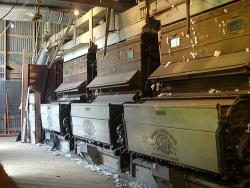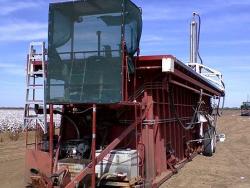Cotton was once transported from farms to gins by wagons, trucks or trailers. Long waits to unload at the gin stalled harvests until haulers could return to the fields.
Professor Lambert Wilkes of the Department of Agricultural Engineering, Texas A&M University, developed the Cotton Module Builder between 1971 and 1974 with the support of J.K. (Farmer) Jones of Cotton Incorporated. The modules created by the Cotton Module Builder withstood weather, and after transport, the cotton could be easily fed into the gin. Dr.
Cotton Gin

YearAdded:
Image Credit: Photo by Beaver (Thomas John Macartney)Image Caption: The cotton module builder revolutionized the cotton industry.Era_date_from: 1971
2002

This is the earliest known survivor of an integrated cotton ginning system widely used to process cotton from wagon to bale in a continuous operation. The gin machinery was designed and built in 1914 by the Lummus Cotton Gin Company. It can process seven bales per hour. Five gin stands, stick machine, burr machine, separators, cleaners, press pump, and pneumatic conveying fans are driven by a 125-hp Bessemer oil engine. This gin ran commercially until 1974 and was restored to operating condition in 1993.
YearAdded:
Image Credit: Courtesy Flickr/John W. Schulze (CC BY 2.0)Image Caption: Burton Farmers Gin MillEra_date_from: 1914
1994
Innovations

This is the earliest known survivor of an integrated cotton ginning system widely used to process cotton from wagon to bale in a continuous operation. The gin machinery was designed and built in 1914 by the Lummus Cotton Gin Company. It can process seven bales per hour. Five gin stands, stick… Read More

Cotton was once transported from farms to gins by wagons, trucks or trailers. Long waits to unload at the gin stalled harvests until haulers could return to the fields.
Professor Lambert Wilkes of the Department of Agricultural Engineering, Texas A&M University, developed the Cotton Module… Read More


